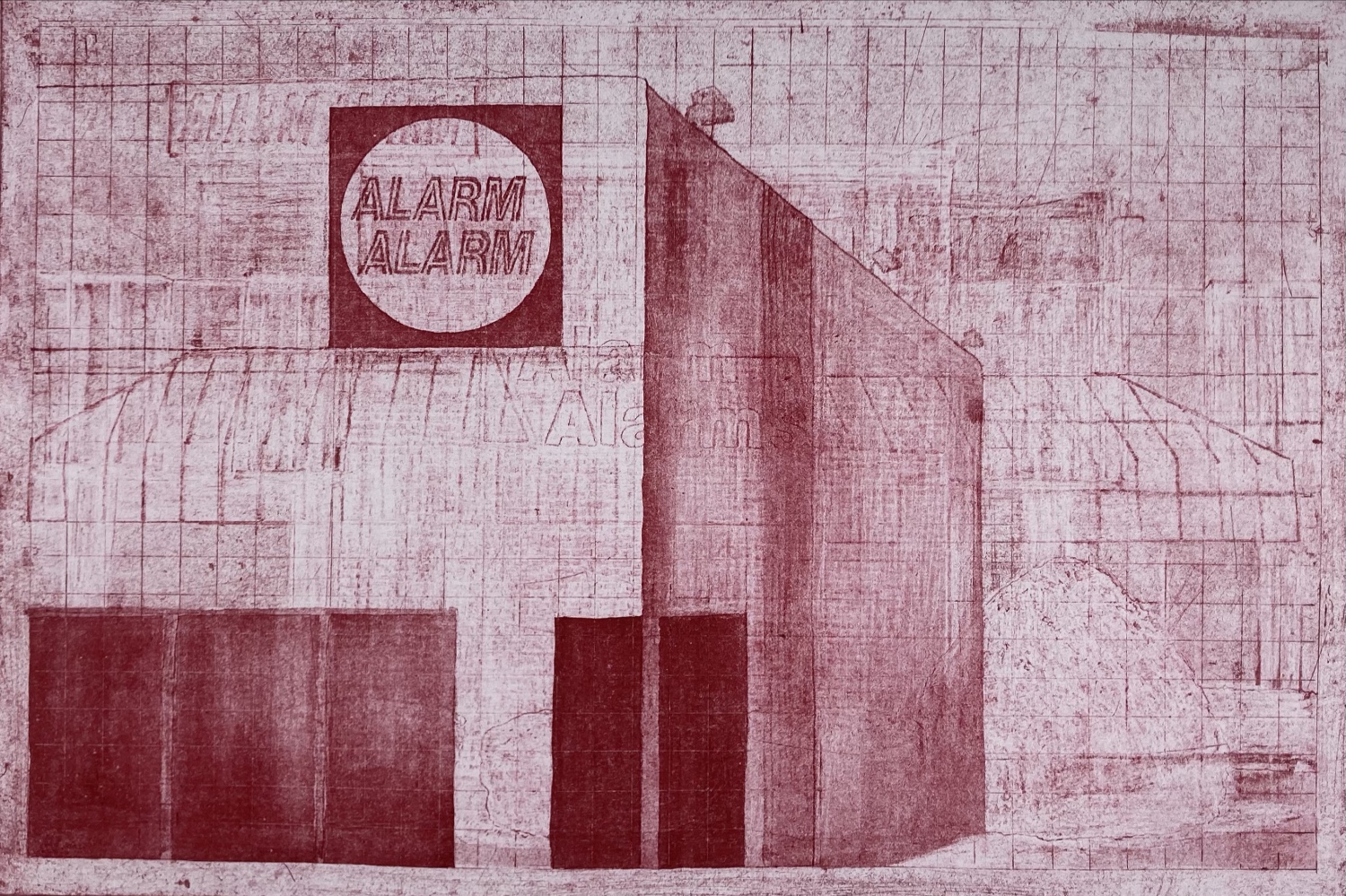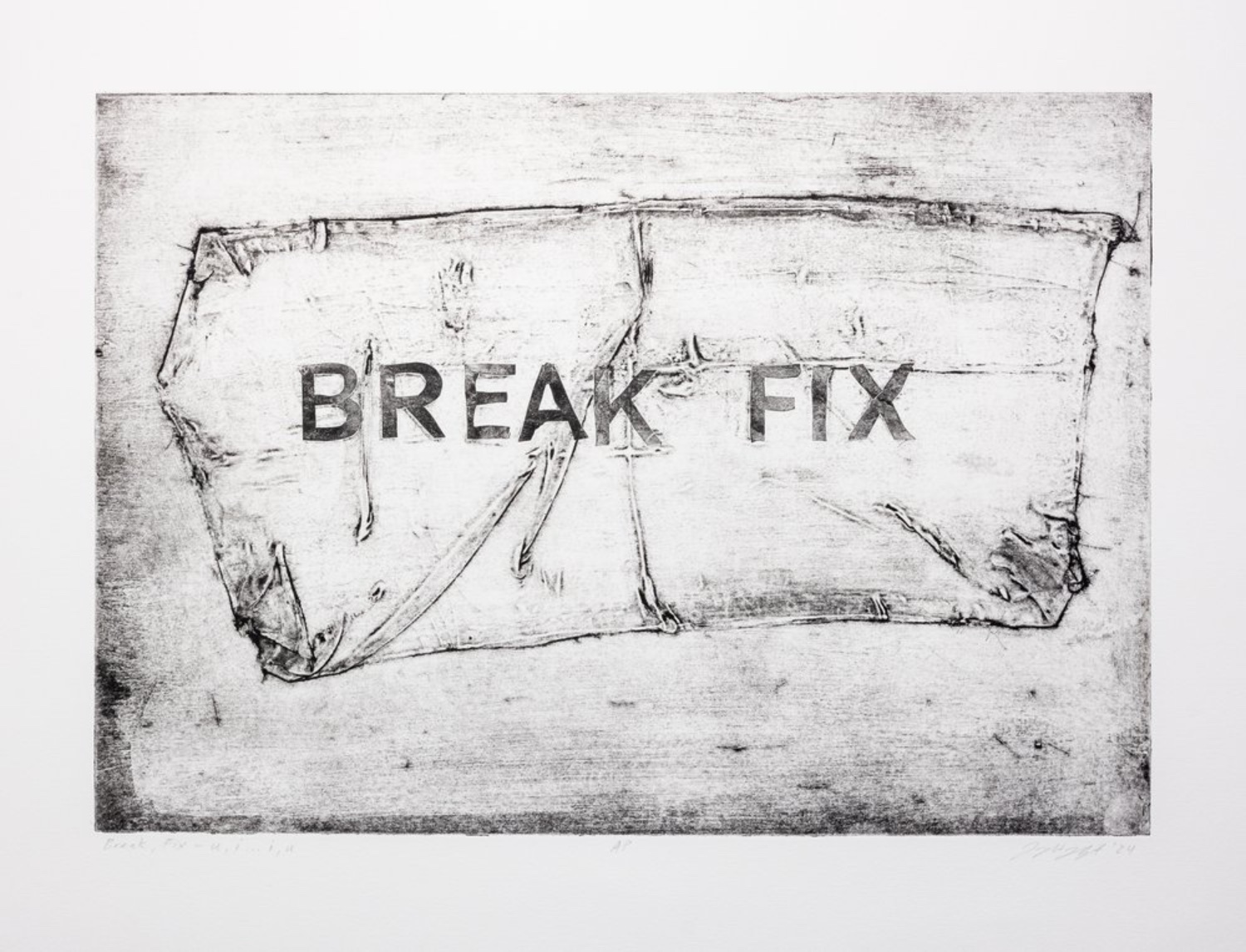
Jeremy Lundquist: Looking for light in the fog
Published November 4th, 2024 by Carl Atiya Swanson
Progressive degradation illuminates a quarter century of American political propaganda in 'Alarm, Cease, Repair, Repeat' at Hamline University
Banner image: Jeremy Lundquist, Promises Made #3 and #4, 2018. Each: Lithograph, 22" x 30"
This review is being written in late October of 2024, and by the time you read it, an election may or may not have happened. To write about the art and politics of Jeremy Lundquist: Alarm, Cease, Repair, Repeat, on view through November 15 at the Soeffker Gallery at Hamline University, is then like describing the air between an inked plate and the paper before it is run through the press. Like the show itself, it is pressurized, expectant, and flattened.
The show comprises new printmaking work from Lundquist, as well as thematically linked pieces from the last decade or so. Split into two galleries, the entry gallery is more personal (which we know is political), while the interior gallery steps into a fog of American political communication and obfuscation.
Laid out in the entry gallery, the 2021 series Alarm Alarm is maybe the most concise and effective marriage of content and process in the exhibition. The eight etchings show a series of building exteriors with the text “Alarm Alarm,” inspired by the signage on a building not far from Lundquist’s home. The prints are progressive etchings, each pulled from the same plate, so that each different building, each iteration of the “Alarm Alarm” text leaves its ghost impression on the subsequent etching. The cumulative effect is a clash of bright colors with a literal impression of terror, a manifestation of the way trauma and fear response accumulates in the body, and as we know from books like The Body Keeps the Score, is passed down from generation to generation.

 Top: Jeremy Lundquist, Alarm Alarm #3, Peoria, IL, 2021. Progressive etching, 12 x 18". Bottom: Alarm Alarm #4, Santa Clara, CA, 2021. Progressive etching, 12 x 18". Images courtesy of the artist's website.
Top: Jeremy Lundquist, Alarm Alarm #3, Peoria, IL, 2021. Progressive etching, 12 x 18". Bottom: Alarm Alarm #4, Santa Clara, CA, 2021. Progressive etching, 12 x 18". Images courtesy of the artist's website.
Stepping into the interior gallery, that accumulated response is on display, with images stretching from the Civil War to contemporary times, with specific focus on post-9/11 War on Terror and recent presidential campaigns. In the center of the gallery, 2024’s Presenter Note is in direct communication with 2013’s Stability Dynamics, which takes up a full wall. Presenter Note is laid out on a table, a bound collection of monotypes of the same military PowerPoint note, instructing the presenter to discuss how better information allows for better targeting of force and use in PsyOps campaigns. The reds, oranges, and yellows echo the color coded threat level warnings of the 2000s, and their forceful insistence is in contrast to Stability Dynamics, which is a muddy, swirling collection of prints of a deliberately obtuse chart of the cultural, political, and military dependencies in Afghanistan. That chart is so obscure that General Stanley McChrystal is quoted in the wall text, “When we understand that slide, we will have won the war.”
On the wall next to Stability Dynamics is Promises Made, a 2018 lithographic series of Donald Trump’s red, white, and blue campaign poster declaring the same phrase. What starts as direct reproduction degrades over six prints to a field of bloody red — draw your own conclusions there. The Appreciations series that follows includes imagery of laurels, handshakes drawn from historical photographs and newspaper clippings, and in one print that is made of cut and re-assembled prints, the treaty table of Ulysses S. Grant that is still in the White House and in use today. The 2023 series Appreciations: Handshakes 1-18 fills another whole wall, each print highlighting a selected handshake. The repetition is almost bludgeoning, declaring an overwhelming sense of victory, of accomplishment, of unquestioning agreement.
 Detail of work, courtesy of the artist's Instagram.
Detail of work, courtesy of the artist's Instagram.
The constant contradiction in political art is the simultaneous truth of Woody Guthrie’s “This machine kills Fascists” guitar and Kurt Vonnegut’s summation of the impact of artists in stopping the Vietnam War: “The power of this weapon turns out to be that of a custard pie dropped from a stepladder six feet high.” The works in the interior gallery of Alarm, Cease, Repair, Repeat fall somewhere closer to the Vonnegut of it all, a record of the ladder rungs we’re climbing on a loop, the way that we attempt to speak about and view history turn into ways of repeating it.
Even though we may be in this compacted loop of obfuscation, that is not necessarily the final endpoint or only state of being. As therapist and activist Resmaa Menakem put it in his book on racialized trauma and somatic healing, My Grandmother’s Hands, “In today’s America, we tend to think of healing as something binary: either we’re broken or we’re healed from that brokenness. But that’s not how healing operates, and it’s almost never how human growth works. More often, healing and growth take place on a continuum, with innumerable points between utter brokenness and total health.”
This is what makes the Repair Repair series that faces Alarm Alarm in the exterior gallery so necessary — with looser techniques, more variety of imagery, less compacted layering, the implication that repair exists in experimentation and creativity is fittingly one of the last things that you see as you leave the gallery. Take a breath, we’re going to do it all over again soon enough. ◼︎

 Top: Jeremy Lundquist, BREAK, FIX… u,i… i,u, 2024. Collagraph print. Bottom: Installation view, photo by Cory Ryan, CT RYAN Photography. Images courtesy of the gallery.
Top: Jeremy Lundquist, BREAK, FIX… u,i… i,u, 2024. Collagraph print. Bottom: Installation view, photo by Cory Ryan, CT RYAN Photography. Images courtesy of the gallery.
____________
A coda, of sorts: For an additional take on the post-9/11 shock and creative response, over at the Minneapolis Institute of Arts, works from Pueblo potter Jody Folwell are currently on display, and the pieces made in the wake of 9/11 are particularly striking. Across large vases, President Bush is presented as a charging cowboy while Osama bin Laden hides in the underbrush to ambush him, and phrases like “Don’t push Bush” and “Freedom Riders” ironically pop up. The cartoon-like satire and comic speech bubbles on these classical forms have a dark playfulness to them, because laughter is a response to the absurd, and we laugh to keep from crying. ◼︎
Jeremy Lundquist: Alarm, Cease, Repair, Repeat is on view through November 15 at the Soeffker Gallery at Hamline University. To see more of the artist's work, visit his website or follow him on Instagram @jeremy.lundquist.
We can't do it without you.
Help keep independent arts journalism alive in the Twin Cities.